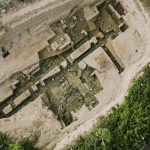A Deadly Heatwave
In August 2019, countries such a Germany, France, and Spain were in the grips of a deadly heatwave that lasted for months. Emergency measures had to be taken, and the people who lived in these countries were miserable. The record-breaking temperatures were also causing a drought. In the Spanish state of Extremadura, the Valdecanas Reservoir was beginning to evaporate due to the heat and lack of rain. For over 50 years, the reservoir dominated the landscape, and now it was disappearing.
Western Spain
According to the legend, mysterious people lived in part of the Iberian Peninsula. While much of their culture has been lost over the years, the legend of a fabulous ancient monument lived on. Nobody knew if it really existed or if the stories were real. Fast forward to the mid-20th century. Extremadura is located in Western Spain. The area is often hot, and they get very little rainfall. Because of this, dictator General Franco thought that if he were going to develop the area, he needed to create a reservoir and a dam in the area.
Building the Reservoir
In 1963, workers flooded the countryside near Peraleda de la Mata, and they built the Valdecanas Reservoir. For decades, the reservoir helped provide water to the people in the region, despite the crippling heat. The heatwave of 2019 created conditions unlike anything seen in the area. This resulted in a horrible drought, and local farmers were suffering from severe hardship. Their crops weren’t getting any water, and the heat was killing them.
Severe Drought
The hot weather caused everything to dry up. Even the Valdecanas Reservior was affected by the hot weather, and the water level of the lake started to recede. As the residents worried about their water supply disappearing, they noticed something very curious in the middle of the reservoir. According to the legend, there was a remarkable artifact hidden under the water, and now that the water level was receding, secrets were about to be revealed.
The Legend
According to the locals, there is a mysterious ancient monument called the Dolmen de Guadalperal. It is said to have been built several thousands of years ago. It is believed to have been build with 150 stones arranged in a stone pattern. Also, it is 16-feet in diameter. The rocks create an enclosed chamber lying horizontally. At the entrance of the monument, carvings can be found. Angel Castano is a local who grew up in the area. He heard that the monument was built using stones from the area. Unfortunately, the exact method of creating the monument had been lost over time. Some people called it the Spanish Stonehenge, even though nobody knew if it existed.
The Purpose
While nobody knows how the monument was built, Angel did know why. According to the legend, the monument formed a sun temple and burial ground. It had a religious purpose, but also an economic one. The monument created a few points in the river where traveling was possible, so it created a trading hub.
1920s
It is believed that the Romans knew that the monument existed, but it wasn’t officially discovered until the 1920s. That was the same time that a German historian named Hugo Obermaier began investigating the area. During the exploration, many relics, including ancient knives, axes, and ceramics, were discovered. They also found ancient residences and mills for sharpening stones. It took 30 years before his find was made public. By that point, the plans for the reservoir were already underway. By then, it was too late, and the monument was covered with water.
Reemerged
Over the last couple of decades, a few sections of the monument appeared to be coming up over the water, and many thought that the legend could be true. In 2019, as the hot summer scorched the landscape of Extremadura, the people found that the legend was true. Finally, the ancient monument reemerged.
A Spectacular Sight
According to locals like Angel, the monument is a spectacular sight. The people in the area had heard about the legend their whole lives, and finally, they were able to see the entire complex in all its glory. With the monument above water, residents were able to come up with their own theories regarding why it was built in the first place.
The Earliest Map
Angel and others believe that the line on the stone doesn’t represent a snake, but instead, a body of water. They think that it shows the Tagus River, which is nearby. It is believed that this carving makes it one of the earliest maps in human history. When Angel heard the theory, he got a river map to compare it to the snake’s head, and the two matched up perfectly. When drought caused a reservoir in Spain to dry up, it exposed a long-lost ancient monument, and it turned out to be so much more.


